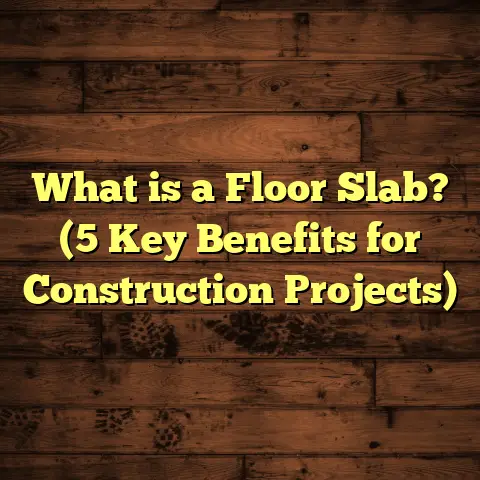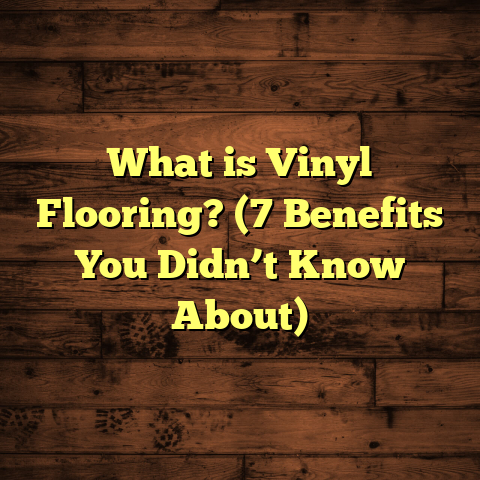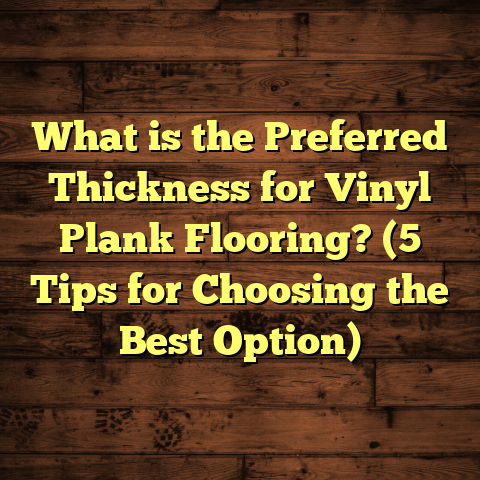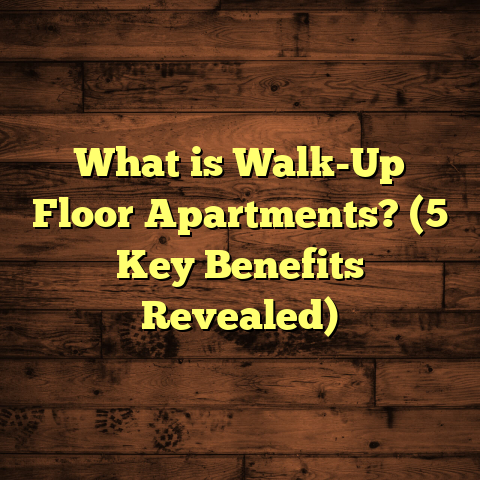What is Vinyl and PVC Wall and Flooring? (5 Key Benefits Revealed)
The Opportunity in Vinyl and PVC Wall and Flooring
Have you ever noticed how just changing your floors or walls can completely transform the feel of a room? I know from my years as a flooring contractor that even small upgrades can make a huge difference. But sometimes, budgets and time constraints hold people back from making those changes.
That’s where vinyl and PVC wall and flooring come into play. These materials open up a world of possibilities for homeowners who want durable, stylish, and affordable solutions without a long installation wait or complicated upkeep. Whether you want a quick kitchen refresh or a basement makeover that can handle moisture, vinyl and PVC might be exactly what you’re looking for.
I’ve worked with these materials in all kinds of homes and climates—from wet Seattle basements to sunny Florida kitchens—and the results were always impressive. Let me walk you through what these materials really are, why they’re so popular, and how they might be perfect for your next project.
What is Vinyl and PVC Wall and Flooring?
When I’m talking with clients and people new to flooring, I often get asked: “What exactly is vinyl flooring? How does PVC fit into this?” It’s a good question because the terms sometimes confuse folks.
Vinyl Flooring Explained
Vinyl flooring is made primarily of synthetic materials based on polyvinyl chloride (PVC). It’s a versatile plastic that can be modified with additives to create flexible, durable sheets or planks. Vinyl flooring usually comes in three main types:
- Sheet Vinyl: Large rolls cut to fit the room; often 6 to 12 feet wide. Thickness ranges from 1.5mm to 5mm.
- Luxury Vinyl Tile (LVT): Individual tiles that mimic natural stone or ceramic tile. Thickness typically 3mm to 6mm.
- Luxury Vinyl Plank (LVP): Long planks designed to look like hardwood floors. Usually between 4mm to 8mm thick.
The surface layers contain wear layers made from clear vinyl or urethane coatings that protect against scratches and stains.
PVC Wall Panels
PVC wall panels are flat sheets or tiles made of the same polyvinyl chloride material but designed for vertical installation. They’re popular in wet areas like bathrooms, laundry rooms, and kitchens because they resist moisture and mold better than drywall or traditional tile grout lines.
PVC wall panels come in thicknesses from 3mm up to 10mm depending on the product’s intended use. Many have decorative finishes ranging from faux wood grain to glossy solid colors.
The Science Behind It
PVC is produced by polymerizing vinyl chloride monomers. The resulting plastic can be rigid or flexible depending on the plasticizers added during manufacturing.
- Flexibility: Achieved by adding plasticizers; flexible vinyl is used in flooring to allow some give.
- Durability: PVC’s molecular structure makes it resistant to water, chemicals, and wear.
- Water Resistance: Unlike natural materials such as wood or stone, vinyl and PVC do not absorb moisture.
- Fire Resistance: Many products are treated with fire retardants for safety compliance.
Materials Breakdown by Layer (Example: Luxury Vinyl Plank)
- Wear Layer (0.3mm to 0.7mm)
Transparent top coat protecting against scratches and stains. - Design Layer
Printed high-resolution image of wood, stone, or tile. - Core Layer
Provides stability; can be rigid or flexible PVC. - Backing Layer
Stabilizes the plank and provides moisture barrier.
Key Measurements and Costs You Should Know
Understanding thickness and cost factors helps when planning your project.
| Material Type | Thickness (mm) | Cost per sq ft (installed) | Lifespan (years) |
|---|---|---|---|
| Sheet Vinyl | 1.5 – 5 | $2 – $4 | 8 – 15 |
| Luxury Vinyl Tile | 3 – 6 | $3 – $7 | 10 – 20 |
| Luxury Vinyl Plank | 4 – 8 | $3 – $8 | 15 – 25 |
| PVC Wall Panels | 3 – 10 | $2 – $6 | 15+ |
Installation costs can vary widely by location and surface prep required. For example:
- In urban areas like New York or San Francisco, labor rates can push total costs above $7 per sq ft.
- In more rural or suburban areas, rates might be closer to $2-$4 per sq ft.
- Subfloor prep (leveling, moisture mitigation) can add $0.50-$2 per sq ft.
The timeframe for installation depends on room size, complexity, and product choice but typically:
- Small rooms (100-200 sqft): 1 day
- Medium rooms (300-500 sqft): 2-3 days
- Basements or large open areas: Up to a week
My Story With Vinyl Flooring: Why I Trust It
Early in my career, I was skeptical about vinyl floors. Hardwood was the “gold standard,” I thought. But I learned fast that vinyl handles challenges wood couldn’t.
One project stands out: a family in Portland had a kid who loved spills and messes. Their hardwood floor was constantly scratched and stained. We switched to luxury vinyl plank flooring with a thick wear layer (0.7mm) and a waterproof core. After two years, the floor still looks flawless despite heavy use.
That experience opened my eyes to how practical vinyl is without sacrificing looks.
Benefit #1: Water Resistance That Lasts
Vinyl and PVC are nearly impervious to water damage. That’s why you’ll see them recommended for bathrooms, kitchens, basements—places where moisture is a constant threat.
Why Does Water Resistance Matter?
In my experience, water damage causes more flooring headaches than any other issue. Hardwood swells and warps; laminate delaminates; tile grout stains and cracks.
Vinyl’s water resistance means:
- No swelling or warping even after spills or floods.
- Easier cleanup of wet messes.
- Reduced risk of mold growth beneath the floor.
One client in Houston had flooding during Hurricane Harvey. Their vinyl floors were submerged for several hours but dried out with no damage, unlike neighbors who lost hardwood floors.
Scientific Data
According to the Resilient Floor Covering Institute:
- Vinyl floors have less than 0.1% water absorption rate.
- Waterproof vinyl planks do not swell or change shape after 72 hours submerged in water tests.
- Mold growth is inhibited due to lack of organic material in vinyl surfaces.
Benefit #2: Cost Savings That Add Up
As someone who has balanced budgets on hundreds of projects, I know cost matters—especially when remodeling whole rooms.
Vinyl flooring offers:
- Lower upfront cost than hardwood or natural stone.
- Faster installation reduces labor expenses.
- Minimal maintenance saves money over time.
- Longevity means less frequent replacement.
Breaking Down Costs With Real Examples
For a mid-sized kitchen (200 sq ft):
| Flooring Type | Material Cost | Installation Cost | Total Cost | Lifespan | Cost per Year |
|---|---|---|---|---|---|
| Hardwood | $4,000 | $3,000 | $7,000 | 20 years | $350 |
| Ceramic Tile | $1,500 | $2,000 | $3,500 | 25 years | $140 |
| Luxury Vinyl | $800 | $1,200 | $2,000 | 20 years | $100 |
The numbers speak for themselves—vinyl is often half or less than half the total cost of hardwood with similar lifespan potential when cared for properly.
Benefit #3: Simple Maintenance Makes Life Easier
From my conversations with homeowners, ease of cleaning is a major selling point for vinyl floors.
What Does Maintenance Look Like?
Daily or weekly maintenance includes:
- Sweeping or vacuuming to remove dirt.
- Damp mopping with mild detergent.
- Immediate cleanup of spills to avoid stains.
Unlike hardwoods which require refinishing every few years or tile which demands grout sealing, vinyl requires only simple care routines.
PVC wall panels are just as easy—just wipe with mild soap when needed. No grout scrubbing required!
Benefit #4: Style Flexibility That Fits Your Vision
I love showing my clients samples because vinyl options now come in so many designs you almost can’t tell them apart from real wood or stone.
Design Options Available Today
- Wood-look planks with embossed grain textures.
- Stone-look tiles mimicking marble or slate.
- Brightly colored geometric patterns.
- Metallic finishes for modern spaces.
- Matte or glossy surface sheens.
Luxury vinyl can replicate flooring styles costing triple the price but at a fraction of the cost and effort.
One client wanted reclaimed barn wood look without the maintenance headaches of real wood—vinyl plank nailed it perfectly in their farmhouse kitchen remodel.
Benefit #5: Comfort & Noise Reduction You’ll Appreciate
Hard tile floors can feel cold and hard on your feet. Carpets soften noise but stain easily.
Vinyl strikes a balance by providing softer underfoot comfort with sound dampening qualities when paired with good underlayment.
Why Does This Matter?
Think about standing in your kitchen cooking for long periods—or kids running upstairs—noise and comfort quickly add up as daily annoyances.
Thicker luxury vinyl planks with an attached foam layer absorb sound up to 20 decibels better than tile or hardwood alone.
A Detailed Case Study: Basement Renovation in Seattle
I want to share a project where vinyl flooring really solved multiple problems:
Project Overview
- Location: Seattle, WA
- Size: 900 sq ft basement
- Existing Condition: Damp concrete slab with uneven surface
- Client Concerns: Moisture intrusion; previous carpet destroyed by mold; wanted warm look
- Solution Chosen: Waterproof luxury vinyl plank (LVP) flooring with rigid core technology; PVC wall panels in laundry area
Installation Details
I started by applying a moisture barrier on the concrete slab then leveling it using self-leveling compound—this took two days due to unevenness averaging half an inch difference across the floor.
The LVP planks were installed using a click-lock system over an underlayment with vapor barrier properties.
PVC wall panels were glued directly onto moisture-resistant drywall in laundry area; total panel area about 150 sq ft.
Costs & Timeframe
| Task | Cost | Time |
|---|---|---|
| Subfloor prep | $1,200 | 2 days |
| Vinyl Flooring (material + install) | $4,500 | 3 days |
| PVC Wall Panels | $900 | 1 day |
| Total | $6,600 | 6 days |
Results & Client Feedback
After six months living with the new floor:
- No signs of water damage despite Seattle’s rainy season.
- Very easy cleanup after kids’ spills.
- Warmer underfoot feel compared to concrete.
- Laundry walls look clean and have resisted detergent splashes perfectly.
This project showcases how vinyl and PVC provide practical answers for challenging spaces while delivering style and comfort.
What Current Market Data Shows About Vinyl/PVC Popularity
The market trends back up what I see on the job site every day:
- The global vinyl flooring market was valued at approximately $25 billion in 2023.
- Expected CAGR (compound annual growth rate) is about 6% through 2030.
- In residential markets across the U.S., vinyl accounts for roughly 30% of all new floor installations.
- Key drivers include waterproof properties (especially important post-COVID as people spend more time at home), affordability during inflationary times, and design versatility.
Environmental Considerations: What You Should Know
There’s often concern about plastics like PVC harming the environment:
Pros:
- Long lifespan reduces frequent replacements.
- Many manufacturers recycle old vinyl into new products.
- Modern production methods have lowered emissions significantly over past decade.
Cons:
- Production involves chlorine-based compounds.
- Improper disposal can cause pollution if not recycled.
If green credentials are important to you:
- Look for products certified by FloorScore (low VOC emissions).
- Choose brands promoting recycling programs.
I encourage balancing practical benefits with informed choices about sustainability when selecting materials.
Choosing the Right Product for Your Home: What I Recommend
Ask yourself these questions before buying:
- How much water exposure? Bathrooms/kitchens need waterproof LVP or sheet vinyl.
- Traffic levels? High traffic means thicker wear layers (20 mils+).
- Design preferences? Wood-look planks? Stone tiles? Colorful patterns?
- Installation method? Glue down vs click-lock vs loose lay?
- Budget constraints? Sheet vinyl is cheapest upfront; luxury vinyl more costly but more stylish/durable.
- Comfort & noise? Consider underlayment thickness for cushion/sound absorption.
For walls:
- Wet areas = PVC panels with smooth sealed edges.
- Dry areas = decorative PVC panels in variety of finishes work well too.
When you work with your contractor or supplier, share these priorities so they can recommend specific product lines that fit your needs precisely.
Installation Tips From Someone Who’s Done It All
Here are some lessons I’ve learned through years of installing vinyl floors:
Subfloor Prep Is Key
Uneven surfaces cause lippage (uneven edges between planks), which looks bad and creates trip hazards. Always level subfloors before installing vinyl flooring.
Allow Expansion Gaps
Vinyl expands slightly with heat changes. Leave at least a quarter-inch gap around perimeter covered by baseboards or molding.
Choose the Right Adhesive
If glue-down installation is specified, use adhesives recommended by manufacturer for your subfloor type (concrete vs plywood).
Acclimate Flooring
Allow planks or sheets to acclimate in room temperature for at least 48 hours before installation—this reduces shrinkage/expansion issues post-installation.
Use Quality Tools
A sharp utility knife for cutting sheet vinyl; tapping blocks for click-lock planks; seam rollers for glued seams make a big difference in finish quality.
Maintenance Advice To Keep Floors Looking New for Years
Simple habits go far:
- Sweep/vacuum regularly to prevent grit scratches.
- Use mats at entrances to reduce dirt tracked inside.
- Avoid harsh chemical cleaners — mild soap and water work best.
- Clean spills immediately—especially oils or dyes that might stain wear layers.
- Inspect edges periodically for lifting or gaps caused by humidity changes.
- Consider professional deep cleaning every few years depending on traffic levels.
With these steps, most luxury vinyl floors maintain their beauty well beyond their warranty periods.
Design Inspiration: Where Vinyl/PVC Shine in Home Décor
Here are some room ideas where these materials can transform spaces:
Kitchens
Vinyl plank mimics hardwood perfectly but without worrying about water near sinks or spills near stoves. Combine with PVC backsplash panels for easy cleanup behind counters.
Bathrooms
Waterproof flooring plus wall panels mean no grout lines full of mold. Choose bright patterns or natural stone looks for spa-like feel without expense of tile installation labor.
Basements and Laundry Rooms
Concrete slabs aren’t pretty or comfortable. Vinyl covering adds warmth plus moisture barrier protection while PVC walls resist detergent splashes and humidity damage.
Living Rooms & Bedrooms
Modern vinyl looks so real now that it’s indistinguishable from wood at casual glance—at lower cost and easier upkeep than carpet or hardwood.
Comparing Vinyl/PVC With Other Flooring Options
Sometimes clients ask me how vinyl stacks up against other popular materials:
| Feature | Vinyl/PVC | Hardwood | Laminate | Tile |
|---|---|---|---|---|
| Water Resistance | Excellent | Poor | Moderate | Excellent |
| Installation Speed | Fast (1–3 days) | Slow (5–7 days) | Fast (2–3 days) | Slow (5–10 days) |
| Initial Cost | Low to Moderate | High | Moderate | Moderate to High |
| Maintenance | Easy | Difficult | Moderate | Moderate |
| Comfort Underfoot | Good | Good | Moderate | Poor |
| Design Variety | Very High | Moderate | Moderate | High |
| Longevity | Good (15–25 years) | Very High (30+ years) | Moderate (10–15 yrs) | Very High |
Vinyl often wins on practicality especially where moisture and budget constraints exist but hardwood’s timeless appeal still attracts many buyers willing to invest more upfront.
Final Thoughts On My Experience With Vinyl & PVC Walls & Floors
After installing hundreds of projects using these materials over more than a decade, here’s what I’d tell any friend considering them:
Vinyl flooring offers an unbeatable mix of durability, style options, water resistance, comfort, and affordability that few other materials match right now. The technology behind these products keeps improving too—new cores offer better rigidity without losing flexibility; wear layers get tougher every year; designs become more realistic all the time.
PVC wall panels complement floors perfectly in wet or demanding spaces where paint or tile grout would struggle long-term.
If you want a hassle-free upgrade that lasts decades without breaking the bank or requiring constant care—vinyl and PVC walls/floors deserve serious attention on your shortlist.
Feel free to reach out if you want personalized advice based on your home’s needs—I enjoy helping people find exactly the right product so they love their home even more!
Would you like me to help you estimate costs using tools like FloorTally based on your exact room sizes? Or want recommendations on specific brands/products available near you? Just ask!





